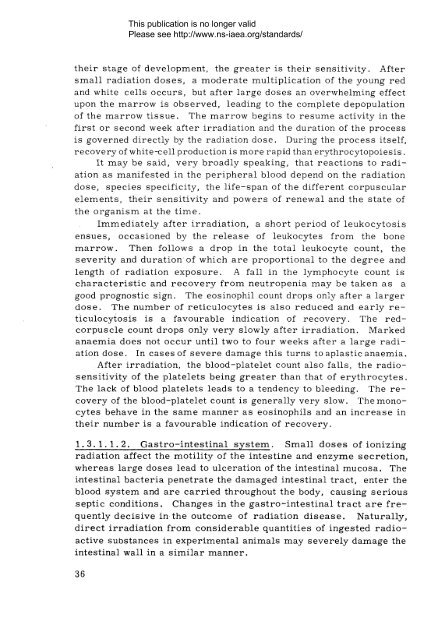Safety_Series_025_1968 - gnssn - International Atomic Energy ...
Safety_Series_025_1968 - gnssn - International Atomic Energy ...
Safety_Series_025_1968 - gnssn - International Atomic Energy ...
You also want an ePaper? Increase the reach of your titles
YUMPU automatically turns print PDFs into web optimized ePapers that Google loves.
This publication is no longer validPlease see http://www.ns-iaea.org/standards/th eir stage of developm ent, the g rea ter is th eir sen sitivity. A ftersm a ll radiation d o se s, a m od erate m u ltip lication of the young redand white cells occu rs, but after large doses an overwhelm ing effectupon the m arrow is observed , leading to the com plete depopulationof the m arrow tissu e. The m arrow begins to resum e activity in thefirst or second week after irradiation and the duration of the p rocessis governed d irectly by the radiation dose. During the p rocess itself,recov ery of white-cell production is m ore rapid than eryth rocytop oiesis.It m ay be said, v e ry b roa d ly speaking, that rea ction s to ra d iation as m anifested in the p erip h eral blood depend on the radiationd ose, sp ecies sp ecificity , the life-sp a n of the different corp u scu larelem ents, their sen sitivity and pow ers of renew al and the state ofthe organ ism at the tim e.Im m ediately after irra d ia tion , a sh ort p eriod of le u k o cy to sisensues, occasion ed by the relea se of leukocytes from the bonem a rrow . Then follow s a drop in the total leu kocyte count, these v e rity and duration o f which are p rop ortion a l to the d e g re e andlength of radiation exposu re. A fall in the lym phocyte count isc h a ra cte ris tic and r e c o v e r y fro m neutropenia m ay be taken as agood prognostic sign. The eosinophil count drops only after a largerd o se. The num ber of re ticu lo cy te s is a lso reduced and early r e -ticu locy tosis is a favourable indication of re co v e ry . The r e d -corp u scle count drops only very slow ly after irra d iation . M arkedanaem ia does not o ccu r until two to fou r weeks after a la rge ra d iation dose. In cases of severe damage this turns to aplastic anaemia.A fter irradiation, the blood-platelet count also falls, the ra d iosensitivity of the p latelets being g rea ter than that of e ry th ro cy te s.The lack of blood platelets leads to a tendency to bleeding. The r e covery of the blood-platelet count is generally very slow. The m onocytesbehave in the sam e m anner as eosinophils and an in crea se inth eir num ber is a favourable indication o f re co v e ry .1.3. 1.1. 2. G a s tro -in te s tin a l s y s t e m . S m all d o s e s o f ion izin gradiation affect the m otility o f the intestine and enzym e secre tio n ,whereas large doses lead to ulceration of the intestinal m ucosa. Theintestinal bacteria penetrate the dam aged intestinal tract, enter theblood system and are ca rrie d throughout the body, causing seriou ssep tic con d ition s. Changes in the g a stro -in te stin a l tra ct a re f r e quently d e cis iv e in the ou tcom e o f radiation d is e a s e . N aturally,d ire ct irra d ia tion fro m con sid e ra b le quantities of in gested r a d io active substances in experim ental anim als may severely damage theintestinal wall in a sim ilar m anner.36
















